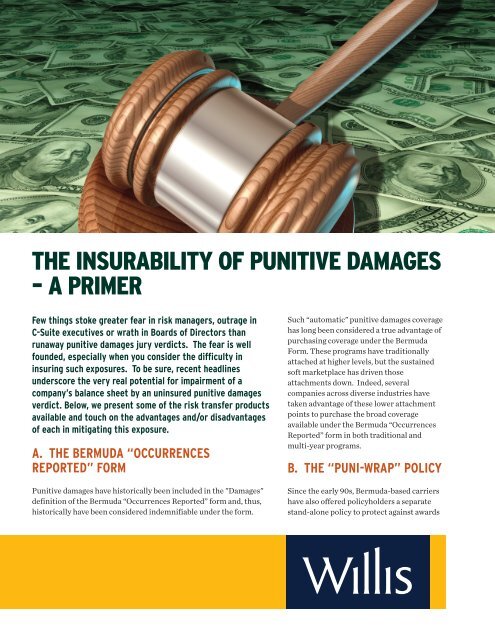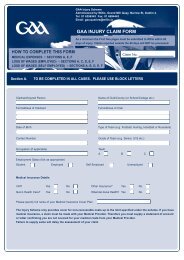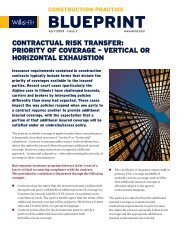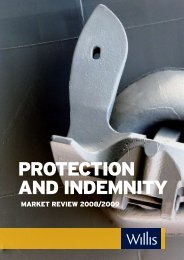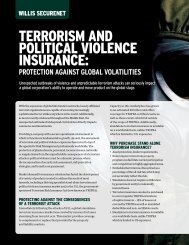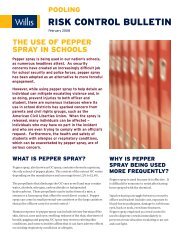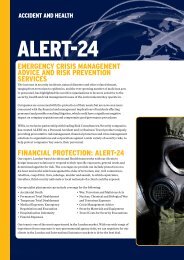THE INSURABILITY OF PUNITIVE DAMAGES – A PRIMER - Willis
THE INSURABILITY OF PUNITIVE DAMAGES – A PRIMER - Willis
THE INSURABILITY OF PUNITIVE DAMAGES – A PRIMER - Willis
You also want an ePaper? Increase the reach of your titles
YUMPU automatically turns print PDFs into web optimized ePapers that Google loves.
<strong>THE</strong> <strong>INSURABILITY</strong> <strong>OF</strong> <strong>PUNITIVE</strong> <strong>DAMAGES</strong><br />
<strong>–</strong> A <strong>PRIMER</strong><br />
Few things stoke greater fear in risk managers, outrage in<br />
C-Suite executives or wrath in Boards of Directors than<br />
runaway punitive damages jury verdicts. The fear is well<br />
founded, especially when you consider the difficulty in<br />
insuring such exposures. To be sure, recent headlines<br />
underscore the very real potential for impairment of a<br />
company’s balance sheet by an uninsured punitive damages<br />
verdict. Below, we present some of the risk transfer products<br />
available and touch on the advantages and/or disadvantages<br />
of each in mitigating this exposure.<br />
A. <strong>THE</strong> BERMUDA “OCCURRENCES<br />
REPORTED” FORM<br />
Punitive damages have historically been included in the "Damages"<br />
definition of the Bermuda “Occurrences Reported” form and, thus,<br />
historically have been considered indemnifiable under the form.<br />
Such “automatic" punitive damages coverage<br />
has long been considered a true advantage of<br />
purchasing coverage under the Bermuda<br />
Form. These programs have traditionally<br />
attached at higher levels, but the sustained<br />
soft marketplace has driven those<br />
attachments down. Indeed, several<br />
companies across diverse industries have<br />
taken advantage of these lower attachment<br />
points to purchase the broad coverage<br />
available under the Bermuda “Occurrences<br />
Reported” form in both traditional and<br />
multi-year programs.<br />
B. <strong>THE</strong> “PUNI-WRAP” POLICY<br />
Since the early 90s, Bermuda-based carriers<br />
have also offered policyholders a separate<br />
stand-alone policy to protect against awards
for punitive damages where the domestic "wrapped" policy is<br />
otherwise prohibited from providing punitive damages coverage due<br />
to public policy, statutory, or regulatory considerations. This policy,<br />
commonly referred to as the “puni-wrap” policy, is offered on an<br />
indemnification basis and is triggered by a judgment in a court of<br />
law. Payments made under the domestic wrapped policy erode the<br />
limits of the puni-wrap policy; therefore, the puni-wrap policy does<br />
not provide an insured with additional limits or coverage per se.<br />
Nevertheless, a puni-wrap policy provides “gap” coverage for<br />
punitive damages verdicts in those 20+ states in which punitive<br />
damages are otherwise deemed uninsurable.<br />
While the insurance industry has long recognized this “gap”<br />
protection as the perceived value of the puni-wrap policy, perhaps its<br />
greater value lies in the alignment of interests puni-wrap coverage<br />
creates between an insured and its insurer in the context of<br />
litigation. Indeed, the determination of whether and when a case<br />
should be settled and the commensurate value of a case often turn on<br />
the merits of the allegations related to the punitive damages<br />
demand. Alignment of interests between insurer and insured<br />
regarding defense strategy, whether to settle or take a case to trial<br />
and case outcome is critical to secure the right result. An insurer,<br />
obligated to defend and/or reimburse an insured for defense costs<br />
regardless of venue, with exposure for both the compensatory and<br />
punitive elements of a case, provides an insured relative certainty<br />
that its interests and that of the insurer are aligned for purposes of<br />
case outcome. However, where an insurer has an obligation to an<br />
insured to defend or reimburse the insured for defense costs but has<br />
no obligation to reimburse the insured for the punitive damages part<br />
of a verdict (or settlement), differences as to case value inherently<br />
exist and may force an insured to contribute the “punitive”<br />
component to a settlement or face the potential for a runaway<br />
verdict in an undesirable trial.<br />
This puni-wrap alternative is offered by various excess insurance<br />
carriers’ Bermuda facilities, such as ACE (ACE Bermuda), Chubb<br />
(Chubb Atlantic), Chartis (Chartis Bermuda), XL (XL Bermuda), and<br />
others.<br />
While large numbers of payments have not been made to date under<br />
the Bermuda puni-wrap policies, no evidence indicates that a<br />
Bermuda-based insurer has been unable to indemnify an insured for<br />
punitive damages due to some regulatory or legal prohibition.<br />
Nevertheless, given this lack of precedent and the recent heightened<br />
regulatory scrutiny placed upon the insurance industry,<br />
policyholders and carriers alike have looked to alternative ways to<br />
insure against the runaway punitive damages verdict.<br />
2<br />
C. <strong>THE</strong> MOST FAVORABLE<br />
VENUE ENDORSEMENT<br />
The Most Favorable Venue (MFV)<br />
Endorsement, touted by domestic carriers as<br />
an alternative to a puni-wrap policy, has<br />
become a popular coverage enhancement<br />
intended to require the contracting parties to<br />
apply the law of the jurisdiction most<br />
favorable for purposes of determining the<br />
insurability of punitive damages. Domestic<br />
carriers have been largely successful in<br />
securing regulatory approval of such<br />
endorsements and offer them in a bold<br />
attempt to compete for business from<br />
insureds otherwise forced to go “off-shore” to<br />
secure affirmative punitive damages coverage.<br />
The question often raised about these<br />
endorsements is: can two parties, otherwise<br />
subject to the laws and regulations of the U.S.,<br />
contract to apply the law of a specific<br />
jurisdiction simply for purposes of avoiding<br />
the prohibition against the insurability of<br />
such damages by whichever court they find<br />
themselves in? Only time will tell. Whatever<br />
the outcome, as with the puni-wrap<br />
alternative discussed above, perhaps the true<br />
value of the MFV endorsement lies in its<br />
ability to create an alignment of interests<br />
between an insured and an insurer in the<br />
defense of a case where such alignment would<br />
otherwise not exist absent an insurer’s<br />
exposure to punitive damages.<br />
While different insurers take different<br />
approaches to this endorsement and offer<br />
differing language, generally speaking the<br />
endorsements include language such as “the<br />
definition of a claim includes punitive and<br />
exemplary damages, and the enforceability of<br />
this provision shall be governed by such<br />
applicable law that most favors coverage for<br />
such punitive or exemplary damages." The<br />
cost for this endorsement can vary depending<br />
on the risk, operating locations, and the<br />
insurer’s view of the punitive exposure<br />
specific to a particular insured.<br />
<strong>Willis</strong> North America • 07/12
While the endorsement demonstrates a legitimate intent by insurers to provide relative<br />
contract certainty as to coverage for punitive damages, the question remains: what is meant<br />
by "the laws of any jurisdiction that is most favorable to the insurability of such damages?"<br />
While regulators have approved it, the endorsement has yet to meet heightened scrutiny by<br />
the courts and therefore remains a mystery as to whether it will actually work.<br />
CONCLUSION<br />
As brokers and consultants to our risk management clients, we are tasked with assessing risk<br />
and finding viable insurance solutions for them. While the likelihood of being hit with a<br />
punitive damages payment, which cannot be appealed away or reduced, is very small, the risk<br />
remains. Indeed, absent explicit punitive damages coverage, the policyholder has an inherent<br />
and identifiable gap in coverage. Moreover, there is undoubtedly value in securing alignment<br />
of interests between insured and insurer in the defense and outcome of litigation. To those<br />
risk managers who ask: Is there value in purchasing a “puni-wrap” policy? we say simply that<br />
in the unlikely, but possible, event your company gets hit with a punitive damages verdict not<br />
otherwise insurable, we would not want to be in the shoes of the one advising the board that<br />
"well…we have a $20M verdict against us for which we're not insured." If I'm a board<br />
member, the first question that comes to mind is, "Could we have been? Is there insurance<br />
for such a thing?" The answer is "yes" and the ramifications of such a situation would likely<br />
be uncomfortable for the messenger.<br />
CONTACT<br />
For more information contact:<br />
Rob Lane, J.D.<br />
<strong>Willis</strong> Global Solutions<br />
+1 630 362 8290<br />
robert.lane@willis.com<br />
The observations, comments and suggestions we have made in this publication are advisory and are not<br />
intended nor should they be taken as legal or financial advice. Please contact your own legal or financial<br />
adviser for an analysis of your specific facts and circumstances.<br />
3<br />
<strong>Willis</strong> North America • 07/12


